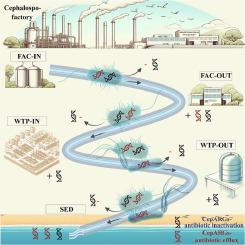当前位置:
X-MOL 学术
›
Water Res.
›
论文详情
Our official English website, www.x-mol.net, welcomes your feedback! (Note: you will need to create a separate account there.)
Dynamic migration and risk of cephalosporin antibiotic resistance genes: Move from pharmaceutical plants through wastewater treatment plants to coastal tidal flats sediments
Water Research ( IF 11.4 ) Pub Date : 2024-06-21 , DOI: 10.1016/j.watres.2024.121983 Chifei Dong , Zishu Liu , Lin Zhu , Baofeng Zhang , Taolve Chi , Zhendi Yu , Meng Zhou , Lingtao Sun , Yuxiang Zhao , Lizhong Zhu , Baolan Hu
Water Research ( IF 11.4 ) Pub Date : 2024-06-21 , DOI: 10.1016/j.watres.2024.121983 Chifei Dong , Zishu Liu , Lin Zhu , Baofeng Zhang , Taolve Chi , Zhendi Yu , Meng Zhou , Lingtao Sun , Yuxiang Zhao , Lizhong Zhu , Baolan Hu

|
The migration and dissemination of antibiotics and their corresponding antibiotic resistance genes (ARGs) from pharmaceutical plants through wastewater treatment to the environment introduce exogenous ARGs, increasing the risk of antibiotic resistance. Cephalosporin antibiotics (Ceps) are among the most widely used antibiotics with the largest market scale today, and the issue of resistance is becoming increasingly severe. In this study, a cephalosporin pharmaceutical plant was selected and metagenomic analysis was employed to investigate the dissemination patterns of cephalosporin antibiotics (Ceps) and their ARGs (CepARGs) from the pharmaceutical plant through the wastewater treatment plant to tidal flats sediments. The findings revealed a significant reduction in the total concentration of Ceps by 90.32 % from the pharmaceutical plant's Pioneer Bio Reactor (PBR) to the effluent of the wastewater treatment plant, and a notable surge of 172.13 % in the relative abundance of CepARGs. It was observed that CepARGs originating from the PBR could migrate along the dissemination chain, contributing to 60 % of the CepARGs composition in tidal flats sediments. Microorganisms play a crucial role in the migration of CepARGs, with efflux-mediated CepARGs, as an intrinsic resistance mechanism, exhibiting a higher prospensity for migration due to their presence in multiple hosts. While Class I risk CepARGs are present at the pharmaceutical and wastewater plant stages, Class I ina-CepARGs are completely removed during wastewater treatment and do not migrate to the environment. This study reveals the dynamic migration characteristics and potential risk changes regarding Ceps and CepARGs in real dissemination chains, providing new theoretical evidence for the mitigation, control, and risk prevention of CepARGs.
中文翻译:

头孢菌素抗生素抗性基因的动态迁移和风险:从制药厂通过废水处理厂迁移到沿海滩涂沉积物
抗生素及其相应的抗生素抗性基因(ARG)从制药厂通过废水处理迁移和传播到环境中,引入了外源ARG,增加了抗生素耐药性的风险。头孢菌素类抗生素(Ceps)是当今使用最广泛、市场规模最大的抗生素之一,其耐药性问题日益严重。在这项研究中,选择了一家头孢菌素制药厂,并采用宏基因组分析来研究头孢菌素抗生素(Ceps)及其ARG(CepARGs)从制药厂通过废水处理厂到滩涂沉积物的传播模式。研究结果显示,从制药厂的先锋生物反应器 (PBR) 到废水处理厂的废水中,Cep 的总浓度显着降低了 90.32%,CepARG 的相对丰度显着增加了 172.13%。据观察,源自 PBR 的 CepARG 可以沿着传播链迁移,占滩涂沉积物中 60% 的 CepARG 组成。微生物在 CepARG 的迁移中发挥着至关重要的作用,外排介导的 CepARG 作为一种内在的抗性机制,由于其存在于多个宿主中而表现出更高的迁移倾向。虽然 I 类风险 CepARG 存在于制药厂和废水处理厂阶段,但 I 类 ina-CepARG 在废水处理过程中被完全去除,不会迁移到环境中。 该研究揭示了Ceps和CepARGs在真实传播链中的动态迁移特征和潜在风险变化,为CepARGs的缓解、控制和风险防范提供了新的理论依据。
更新日期:2024-06-21
中文翻译:

头孢菌素抗生素抗性基因的动态迁移和风险:从制药厂通过废水处理厂迁移到沿海滩涂沉积物
抗生素及其相应的抗生素抗性基因(ARG)从制药厂通过废水处理迁移和传播到环境中,引入了外源ARG,增加了抗生素耐药性的风险。头孢菌素类抗生素(Ceps)是当今使用最广泛、市场规模最大的抗生素之一,其耐药性问题日益严重。在这项研究中,选择了一家头孢菌素制药厂,并采用宏基因组分析来研究头孢菌素抗生素(Ceps)及其ARG(CepARGs)从制药厂通过废水处理厂到滩涂沉积物的传播模式。研究结果显示,从制药厂的先锋生物反应器 (PBR) 到废水处理厂的废水中,Cep 的总浓度显着降低了 90.32%,CepARG 的相对丰度显着增加了 172.13%。据观察,源自 PBR 的 CepARG 可以沿着传播链迁移,占滩涂沉积物中 60% 的 CepARG 组成。微生物在 CepARG 的迁移中发挥着至关重要的作用,外排介导的 CepARG 作为一种内在的抗性机制,由于其存在于多个宿主中而表现出更高的迁移倾向。虽然 I 类风险 CepARG 存在于制药厂和废水处理厂阶段,但 I 类 ina-CepARG 在废水处理过程中被完全去除,不会迁移到环境中。 该研究揭示了Ceps和CepARGs在真实传播链中的动态迁移特征和潜在风险变化,为CepARGs的缓解、控制和风险防范提供了新的理论依据。











































 京公网安备 11010802027423号
京公网安备 11010802027423号